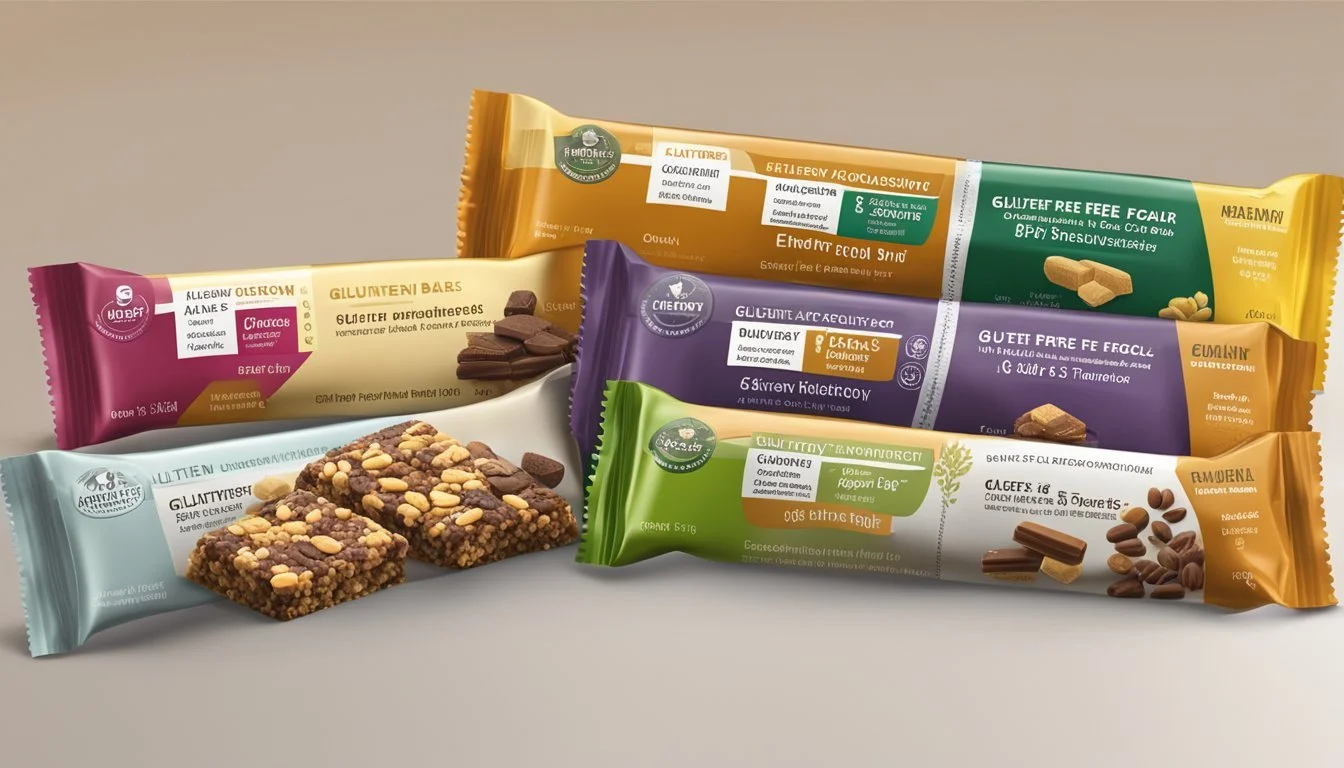Are Energy Bars Gluten-Free?
Decoding their Ingredients for Celiac Safety
The quest for convenient, on-the-go nutrition often leads health-conscious consumers to energy bars, a segment that has seen a proliferation of options tailored for various dietary needs, including gluten-free diets. Energy bars are designed to provide a quick snack that helps sustain energy levels throughout active and busy days. However, not all energy bars are created equal when it comes to being gluten-free. It is essential for those with celiac disease or gluten sensitivity to carefully examine these products before incorporation into their diets.
Gluten is a group of proteins found in wheat, barley, and rye, and it is problematic for individuals with certain health conditions. Energy bars, typically dense in nutrients and calories, may contain gluten through ingredients like grains, additives, or as a result of cross-contamination during production. Fortunately, the market has adapted to the needs of gluten-intolerant consumers, and many brands now offer gluten-free energy bars, using alternatives like nuts, seeds, and gluten-free grains.
Careful label reading is imperative as some energy bars may still contain traces of gluten or be manufactured in facilities where cross-contamination can occur. For assured safety, gluten-free consumers should look for certifications or labels that clearly state the product is gluten-free. There are various brands that cater specifically to the gluten-free audience, ensuring their manufacturing processes and ingredients are safe for those with dietary restrictions.
What Makes a Product Gluten-Free?
In the context of food safety and dietary needs, understanding what qualifies a product as gluten-free is essential, especially for those managing celiac disease or gluten sensitivity. Gluten-free products must omit gluten, a protein found in wheat, barley, and rye, and adhere to strict labeling regulations.
Understanding Gluten and Celiac Disease
Gluten is a group of proteins present in wheat, barley, and rye. For individuals with celiac disease, consuming gluten leads to an immune response that damages the small intestine, hindering nutrient absorption. A gluten-free diet is not a choice but a necessity for these individuals. To be deemed safe, products must not contain any gluten-containing ingredients or be cross-contaminated with gluten-containing grains.
Labeling Standards and Regulations
The U.S. Food and Drug Administration (FDA) defines gluten-free products as those containing less than 20 parts per million (ppm) of gluten. This level is the lowest that can be reliably detected and is generally considered safe for people with celiac disease. Labeling standards require clear indication if a product is gluten-free, wheat-free, or intended as an alternative for those with dietary restrictions. Below are criteria commonly used:
Gluten-Free: Must contain less than 20 ppm of gluten.
Wheat-Free: May still contain gluten from sources other than wheat.
Certified Gluten-Free: Undergoes additional testing by independent organizations to verify gluten content.
Producers may voluntarily use gluten-free labels if they comply with FDA standards, ensuring products are safe for those with celiac disease or gluten intolerance. It's crucial for consumers to check for these labels to manage their health effectively.
Health and Nutritional Benefits of Energy Bars
Energy bars are often tailored to offer a balance of carbohydrates, proteins, and fats, providing a dense source of nutrients for people with active lifestyles or as a convenient snack option.
Macro and Micronutrients
Energy bars typically contain a mixture of macro and micronutrients essential for the body's health and function. Proteins found in energy bars are crucial for muscle repair and growth, often derived from nuts, seeds, or protein isolates. Carbohydrates provide the necessary energy, with sources like whole grains and dried fruits (What wine goes well with dried fruits?) providing both simple and complex forms for quick and sustained energy release.
Common macronutrients found in energy bars:
Protein: Aids in tissue repair and muscle recovery.
Carbohydrates: Acts as a primary energy source, with both quick and slow-release forms.
Fats: Includes healthy fats like omega-3 fatty acids, beneficial for heart health.
Micronutrients such as vitamins and minerals enhance overall wellness. These bars may be enriched with nutrients like calcium, iron, magnesium, and various vitamins, supporting a well-rounded diet.
Energy and Fitness
Energy bars are designed to support energy demands during fitness activities and can be used as a pre-workout boost or a post-workout recovery snack. Their high caloric content, primarily from carbohydrates and fats, offers quick fuel that can enhance performance and endurance during exercise.
Energy and fitness benefits:
Pre-workout: Consuming an energy bar can give an immediate energy surge, optimizing workout performance.
Post-workout: The protein content in these bars facilitates muscle recovery and the repair of tissues damaged during exercise.
It's important to note that not all energy bars are created equally; some might contain added sugars and saturated fats. When choosing an energy bar, individuals should look for products with natural ingredients and a balanced nutrient profile.
Ingredients in Gluten-Free Energy Bars
The composition of gluten-free energy bars tends to revolve around wholesome, natural ingredients that offer nutritional benefits while adhering to gluten-free dietary restrictions. A variety of seeds, nuts, natural sweeteners, and alternative proteins are carefully selected to ensure these snacks (What wine goes well with snacks?) are safe and enjoyable for individuals with gluten intolerance.
Common Ingredients and Alternatives
Gluten-free energy bars commonly include:
Seeds: such as chia seeds, pumpkin seeds, and sunflower seeds, which provide essential nutrients and texture.
Nuts: like almonds, cashews, and peanuts (unless specified as nut-free) for protein and healthy fats.
Natural sweeteners: typically involved are honey, maple syrup, or agave nectar, offering sweetness without the need for artificial sugars.
Fruit-based ingredients: including dates and other dried fruits that deliver natural sugars and carbohydrates.
Fats: commonly originating from nut butters, like peanut and almond butter, or oils such as coconut oil, adding richness and moisture.
Alternatives for allergy considerations include:
Nut-free options often use seeds as their base protein and fat source.
Soy-free and dairy-free alternatives avoid common allergens, using ingredients like hemp seeds for protein.
Understanding Sweeteners and Flavors
Sweeteners in gluten-free energy bars range from natural syrups to fruit extracts, imparting flavors without artificial additives:
Natural syrups: such as honey, maple syrup, and agave nectar, double as sweeteners and binding agents.
Vanilla extract and cinnamon are popular for adding depth to the bar's flavor profile without additional sugars.
Dried fruits not only sweeten but also contribute fruity notes and chewy textures to the bars.
Safety and Allergy Considerations
Manufacturers of gluten-free energy bars usually ensure their products steer clear of cross-contamination with gluten. However, those with additional allergies need to be vigilant:
Labels should be checked for mentions of peanuts or tree nuts if allergies to these are a concern.
Nut-free bars can be made with seeds instead, while soy-free and lactose-free designations cater to those with specific dietary needs.
It's crucial to verify certifications on packaging, as these confirm safety for individuals with celiac disease or gluten sensitivity.
Commercial Gluten-Free Energy Bars
The increasing demand for gluten-free products has led many energy bar manufacturers to offer options suitable for individuals with celiac disease or gluten sensitivity. Consumers can now find a variety of gluten-free energy bars on the shelves of stores, including whole foods markets. It is crucial for these consumers to read and understand labels to ensure these snacks are safe and meet their dietary needs.
Recommended Brands and Options
Several brands have become reputable for providing gluten-free energy bars. These are some specific options that they can safely consume:
KIND Energy Bars: All flavors are certified gluten-free.
Nii Bars: Offers vegan bars with simple ingredients like walnuts, hemp seeds, and quinoa, all confirmed gluten-free.
Oatmega Bars: Known for being gluten-free and soy-free.
BumbleBar: Produces exclusively gluten-free products.
These brands are typically available in health food sections of grocery stores or specialty whole foods stores.
Reading and Understanding Labels
Understanding labeling is essential for those requiring a gluten-free diet. Here are specific things consumers should look for:
Certification Seals: Look for seals from reputable organizations certifying the product as gluten-free.
Ingredient List: Even if a product is labeled gluten-free, it's important to read the list of ingredients for any hidden sources of gluten.
Allergen Warnings: Be aware of any cross-contamination risks by reading allergen warnings.
By thoroughly reading labels, consumers can make informed choices about the nutrients they are consuming and ensure the energy bars they select are both safe and aligned with their dietary restrictions.
Making Your Own Energy Bars
Crafting homemade energy bars allows for customized nutrition and flavors. These treats can be packed with a variety of ingredients such as nut butters, seeds, and dried fruits to cater to individual taste preferences and dietary requirements.
DIY Recipes and Techniques
To create homemade energy bars, one starts with a base of oats or nuts, employing a food processor to combine them with nut butters and dried fruits for natural sweetness and chewiness. Seeds like chia or flax add a crunch and are sources of additional nutrients. A balance of sweeteners—such as honey or maple syrup—enhances the flavor and helps bind the ingredients.
Techniques include:
Mixing: Combine dry and wet ingredients separately, then mix them together thoroughly to ensure even distribution.
Pressing: Use a spatula to press the mixture firmly into a baking dish lined with parchment paper to create a compact layer that will hold together.
Baking or Chilling: One may opt to bake the energy bars to create a firmer texture or simply refrigerate them until set.
Storing and Preservation
Once the bars are set, they should be cut into the desired size. Storage options include:
Refrigerator: Place the bars in an airtight container separated by layers of parchment paper to prevent sticking. They can be kept in the fridge for up to a week.
Freezer: For longer preservation, wrap the bars individually in parchment paper and store them in the freezer. They can be thawed as needed for a quick and satisfying snack.
Following these straightforward steps ensures that one has a stash of tailored energy bars ready for consumption, providing a convenient, delicious, and healthy option for on-the-go nourishment.
Special Considerations for Dietary Needs
When selecting energy bars, individuals with dietary restrictions must carefully consider ingredient lists. Specific dietary needs such as gluten-free, vegan, or the avoidance of major allergens like nuts or soy are of utmost importance for health and wellness.
Vegan and Plant-Based Options
Energy bars suitable for vegans and those following a plant-based diet are designed to avoid animal-derived ingredients. They often draw on plant-based proteins like pea or brown rice protein to provide the necessary nutrients for muscle repair and growth. It's essential to scrutinize labels since some bars might contain honey or other non-vegan components.
Examples of Plant-Based Protein Sources:
Pea Protein
Brown Rice Protein
Energy Bars Without Major Allergens
Individuals with allergies or intolerances need energy bars free from common allergens such as nuts, dairy, or soy. Brands often market their products with clear labeling such as 'nut-free' or 'soy-free' to help consumers identify safe options. For those requiring a gluten-free choice, KIND Energy Bars and certain other brands ensure their products do not contain gluten-containing grains, making them safe for individuals with celiac disease or gluten sensitivity.
Typical Allergen-Free Ingredients:
Gluten-Free Oats
Hemp Seeds
Sunflower Seeds
Consumers should always double-check the ingredient list and manufacturing details to ensure the product meets their specific dietary requirements.
Incorporating Energy Bars Into Your Diet
Energy bars can be a convenient snack option, providing a blend of carbohydrates and protein that is particularly beneficial for active individuals. They are designed for on-the-go consumption and can fit seamlessly into a balanced diet when chosen and timed correctly.
Creating a Balanced Snacking Routine
When integrating energy bars into one's diet, it is crucial to consider their nutritional profile in the context of overall dietary needs. A well-rounded snack routine should include a variety of nutrients. Energy bars often come packed with calories and protein, which can help to fuel the body between meals. However, one should balance their intake with fruits, vegetables, and other protein sources to ensure a broad spectrum of vitamins, minerals, and macronutrients. It's also important to look for energy bars that are gluten-free if one has celiac disease or gluten sensitivity.
Points to Consider:
Variety: Include different food groups in your snacks.
Moderation: Energy bars are calorically dense; consume them as part of a balanced diet.
Gluten-Free Options: Select bars that cater to dietary restrictions as needed.
When to Consume for Optimal Benefit
Pre-Workout: Consuming an energy bar 30-60 minutes before exercise can provide the necessary energy to power a workout. The carbohydrates in the bar fuel the muscles, while the protein content can help with muscle repair and growth.
Workout Timing:
30-60 minutes before: Helps energize your workout.
Avoid consumption immediately before: To prevent digestive discomfort.
Post-Workout: A post-workout snack should be rich in protein and carbohydrates to aid in muscle recovery and replenish glycogen stores. Energy bars that are carefully selected for their protein content can be effective for post-exercise nutrition, but they should be consumed as part of a recovery meal and not as the only source of post-workout nourishment.
Recovery Nutrition:
Within 45 minutes post-exercise: Aids in quicker recovery.
Pair with a carbohydrate-rich snack: Optimizes glycogen replenishment.
In conclusion, energy bars, when chosen with attention to their composition and gluten-free status, can be a valuable addition to an athlete's diet. They should, however, be part of a diverse array of snacks to ensure comprehensive nutritional intake.









